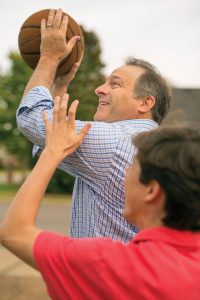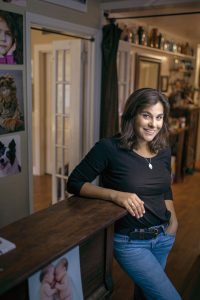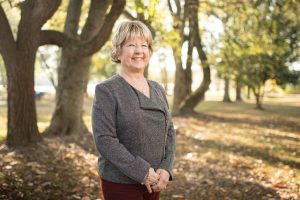Lives Restored
Plastic surgeons help cancer patients rebuild self-esteem
December 6, 2016 | Jill Clendening

Photo by Daniel Dubois.
Looking over his chickens at his home in Tompkinsville, Kentucky, Jerry Ford says taking care of this energetic brood is what kept his spirits up after he had facial reconstructive surgery at Vanderbilt two years ago.
As an HVAC technician Ford often crawled through cobwebbed spaces, so he thought an irritated spot on his right cheek was a spider bite. He went to a physician for treatment, but the spot just got worse. After multiple biopsies, excisions and changing diagnoses, Ford, who by then had a quarter-size hole in his cheek, was referred to a Bowling Green, Kentucky, plastic surgeon. The diagnosis was squamous cell carcinoma. Realizing the cancer was now extensive, the doctor referred Ford to Vanderbilt plastic surgeon Kevin Kelly, M.D., D.D.S., director of the Craniofacial Surgery Center.
Vanderbilt reconstructive surgeons help cancer patients rebuild their lives.
A plastic surgeon might simply close a wound so deftly that only the faintest whisper of an incision remains. Or they might meticulously rebuild and shape structures that have been devastated by cancer, as in Ford’s case.
When squamous cell carcinomas are detected and removed early, they are usually curable and cause minimal damage. However, if left untreated, they can penetrate underlying tissues and become disfiguring. A small percentage even metastasize to local lymph nodes, distant tissues and organs.
The squamous cell carcinoma had spread through Ford’s cheek and into his cheekbone and lower part of his eye socket.
“When I had my surgery with Dr. Kelly, he told me afterward, ‘Mr. Ford, if you hadn’t come in to see me when you did, I don’t think I could’ve done anything for you,’” Ford remembered. “It was that bad.
“I was scared—I’m not going to lie,” Ford said. “When I heard they had to take off part of my face, I knew I would have a big hole. I had never known anyone who had gone through something like this. But they did me good. I can’t say I’ve ever been pretty, but I look fine.”
During a nearly 10-hour surgery, cancerous tissue and damaged bone was removed. Kelly then removed and carved one of Ford’s ribs to form a new cheekbone and a lower eye socket to cradle his eye. Kelly shifted tissue up from Ford’s neck to cover his cheek. Subsequent surgeries refined the shape of Ford’s face, reduced scarring, and tightened the skin around his eye socket.
“You can hide something on your back, but it’s hard to hide something on your face,” said Kelly. “People are understandably sensitive about this. It’s important to give our patients as good a lifestyle as we can, especially after they’ve already had the frightening experience of being told that they have cancer. We let them know early on that there are a lot of things we can do to get them back to a normal life and a normal appearance.”
Kelly credits Vanderbilt’s team approach for the success of even the most complex of reconstructions, and because of the wealth of expertise on site, patients of all ages travel to the Medical Center from a multistate region for reconstructive surgeries. Because children’s bodies are still growing until they are 18 or 19, it’s not uncommon for these patients to need additional reconstructive surgeries through the years, said Kelly.
“Everyone you could possibly need is right here,” he said. “We have dermatologists and surgical oncologists. Then there are dentists and oral surgeons, ophthalmologists, neurosurgeons and otolaryngologists.”
“They had to do what they had to do,” said Ford, who turned 62 in October. “I’m glad I was in these hands at Vanderbilt. They put me back together.”
Nine faculty members in the Department of Plastic Surgery provide solutions for the most complex reconstructions, from head to toe, in both adult and pediatric patients.
“We are committed to the highest level of care for our patients, collaborating with colleagues in other specialties and keeping up to date with the latest cutting-edge innovations,” said Reuben Bueno, M.D., interim chair of the Department of Plastic Surgery.
Preserving an ankle
In January 2015, Nashville attorney Jay Smith decided it was time to get a bothersome cyst removed that had appeared on his right ankle a few years before. He was surprised when a biopsy revealed it was actually a rare form of cancer known as a soft-tissue sarcoma.

Jay Smith worried about losing movement in his ankle after having a tumor removed, but reconstructive surgery preserved his mobility. Photo by Daniel Dubois.
Smith was referred to Vanderbilt orthopaedic oncologist Ginger Holt, M.D., who laid out her plan to remove a larger area of tissue from his ankle in order to ensure all cancer was gone and to reduce the risk of a recurrence. Holt sent him to Vanderbilt reconstructive plastic surgeon Blair Summitt, M.D., so they could discuss how to best preserve the function of his foot and leg.
“It was a very uncertain time, to be honest,” Smith said. “There were big unknowns going into the surgery—whether, because this was in such a sensitive area, I would be able to wear normal shoes again and whether I would get the range of motion in my ankle back.”
Smith lives in Murfreesboro with his wife, Shannon, and two children, Tom and Lily, and he worried about how more surgery might limit his ability to be active with his children’s sports and other events.
“It’s overwhelming when someone gets that cancer diagnosis, so you need to just sit back, talk, and answer questions,” said Summitt. “Patients and their families need to get to know you. I draw diagrams a lot, too.”
Because there is limited tissue on the extremities, especially in bony areas such as a wrist or ankle, reconstruction in these areas poses unique challenges. Bones that can become exposed when cancer is removed must be re-covered and nerves meticulously salvaged to preserve sensation and movement. Summitt’s solution for Smith’s situation was to cut a flap of connective tissue, fat and skin from his calf, and, leaving the blood vessels intact, rotate the flap down to cover his ankle. Doppler ultrasound confirmed there was adequate blood flow into the flap before it was secured into place.
Then, it was a waiting game. Smith remained hospitalized four days, then was sent home with orders for limited weight bearing for three months. His employer, First American Title, let him work at home so he could heal.
“I had no idea reconstructive plastic surgery even existed,” said Smith. “It amazes me what can be done. Years ago, this would’ve been a situation where a limb would’ve been lost. I’m just really grateful to Dr. Summitt and Dr. Holt for putting me back in a position where my day-to-day activities have not been affected.”
Less than two years after his initial diagnosis, Smith has complete range of motion back in his ankle, and he only has a small indention in his calf. He can wear any shoes he wants and, most importantly, if his son asks to shoot hoops or his daughter wants to hit the volleyball, he’s up to the challenge.
One size does not fit all
When faced with a breast cancer diagnosis, patients are not only confronted with critical choices about their treatment, many must also decide what to do about breast reconstruction.
That’s when Vanderbilt reconstructive plastic surgeons specializing in breast reconstruction step in, and their role extends far beyond aesthetics. They listen closely to patients, working with them and their oncology teams to determine the type of surgery that is both the safest choice and the one that best meets the patient’s expectations.
The oncology team refers patients to plastic surgery soon after their diagnosis, and they are often apprehensive and uncertain, said Vanderbilt plastic surgeon Stephane Braun, M.D.
“Apart from having to deal with cancer, there is also often a great loss of sense of self,” Braun said. “I enjoy letting them know things are going to be OK, that there is a plan to get somewhere good from here. As reconstructive plastic surgeons, we are about putting it all back together, and that’s gratifying.”
When Leila Grossman, a Nashville photographer and mother of two, was diagnosed with invasive ductal carcinoma in her left breast, her surgical oncologist recommended a lumpectomy and a six-week course of radiation. Her response was immediate and unwavering: “No, please just remove both my breasts.”

Leila Grossman underwent DIEP flap surgery, one of the most advanced forms of breast reconstructive surgery currently available. Photo by Daniel Dubois.
When she was 14, Grossman had watched her mother begin a battle with breast cancer. Over the next 10 years, Grossman’s two aunts and her grandmother were also diagnosed with breast cancer, and she knew that a great aunt had died from the disease in the 1960s. Grossman’s aunts had mastectomies and had no recurrence. Twelve years after her mother’s diagnosis and mastectomy, cancer returned in her remaining breast. She had it removed and began more treatment.
“She died just three years ago, so she was technically a 29-year survivor,” said Grossman. “With my family history, I had anxiety like you would not believe. I felt it was not something that might happen, but something that I would deal with eventually. I’d never had surgery in my life other than having my wisdom teeth out. The idea of surgery terrified me, yet I had been mentally preparing myself for this for 25 years.”
When she met with her oncologist to discuss her upcoming surgery, she mentioned that following her most recent diagnostic mammogram she noticed a spot of blood in her bra on her unaffected side. After additional testing, Grossman received the devastating news that she had a different breast cancer in her right breast, a non-invasive ductal carcinoma. At that point, Grossman said her decision to remove both breasts made even more sense to her.
Unfortunately, after her double mastectomy and placement of tissue expanders, Grossman developed infections that required surgeries to remove the expanders. She then had to wait six months before anything further could be done. She began doing her own research, and when she first met with Braun to discuss her reconstructive options, almost in the same breath they both said “DIEP flap.”
DIEP stands for the deep inferior epigastric perforator artery that runs through the abdomen. DIEP flap reconstructive surgery, which involves this artery, is one of the most advanced forms of breast reconstruction currently available.
“I didn’t like having nothing at all there on my chest,” said Grossman. “I was in my early 40s, and feeling just my chest wall scared the heck out of me. Dr. Braun felt I was the perfect candidate for this type of surgery. I’d read a lot about it, and I just said, ‘Make ’em cute!’ I also told him I wanted to be able to bounce a quarter off my stomach. I wasn’t kidding.”
In DIEP flap surgery, fat, skin and blood vessels are carefully removed from the abdomen and relocated to rebuild the breast. This also provides the appearance of a tummy tuck because lower abdominal fat is removed. No muscle is removed, as often occurs with other types of tissue-based reconstruction. Using a high-power microscope as well as specialized microsurgical instruments and sutures, the plastic surgeon reattaches the blood vessels of the flap to blood vessels in the chest to re-establish blood flow.
“Traditionally, flaps were musculocutaneous, meaning you moved the muscle with all the blood vessels connected between the muscle and the skin and fat,” Braun explained. “A perforator flap design is a further refinement of that, in which we chase the perforator blood vessels down through the muscle to move them with the flap and leave the muscle there. It’s a subspecialized area of microsurgical free tissue transfer, and that’s one reason this surgery isn’t widely available.”
At Vanderbilt, plastic surgeons Braun and Kye Higdon, M.D., work in tandem to perform DIEP flap surgeries, in concert with a team of anesthesia specialists, nurses and surgical technologists. Using the team approach decreases the time a patient is under anesthesia, improving their overall recovery and experience.
Now, four years after her DIEP flap surgery, Grossman said she couldn’t be happier. “Vanderbilt saved my life. I give several doctors there the credit for me still being here. This is clearly the silver lining of breast cancer for me. I had no lymph node involvement, I didn’t have to have radiation or chemotherapy, and I have new breasts that were made from the belly that my babies gave me.”
Another woman’s choice
Tina Shumate had recently retired from her job as an administrative assistant with the Clarksville-Montgomery County School System when in 2016 she was diagnosed with breast cancer — ductal carcinoma with lymph node involvement. She was overwhelmed. She had been treated successfully for lymphoma in 2008, so she felt like she’d already been down this road. She wanted to focus on spending peaceful hours at her lake home with her two sons. Anything but deal with cancer, again.

Tina Shumate underwent breast reconstruction surgery before chemotherapy. Photo by John Russell.
“I thought I would retire when I was still healthy, and I could do anything I wanted,” she said, laughing. “Then, within a year I got this diagnosis. For a while, I was very, very sad as I was grieving for the time I would lose fighting this disease. I was thinking, ‘Well, this is not what my life is supposed to be. I’m retired, I’ve raised my kids, and now this is my time for me!’”
She worked with her Vanderbilt Breast Center team, medical oncologist Vandana Abramson, M.D., and surgical oncologist Ingrid Meszoely, M.D., to determine a surgery and treatment plan, which included something she was really dreading, post-surgery chemotherapy. Then, she met with Higdon, her plastic surgeon, to come up with a plan for reconstructing her breast after the tumor removal.
“We are fortunate to have such an amazing plastic surgery team at Vanderbilt,” Abramson said. “Patients benefit not just from the technical skills of the plastic surgeons, but also from knowing that there is excellent communication between their providers to provide seamless care.”
Shumate said Higdon’s recommendation to rebuild her breast using her existing breast tissue, a technique called oncoplastic surgery, eliminated a worry that she didn’t think she could live with—a mastectomy. Oncoplastic surgery is a breast-conserving procedure where cancerous tissue is removed by a surgical oncologist with enough clear breast tissue remaining for a plastic surgeon to reconstruct a breast.
As a larger-breasted woman, Shumate had already been considering breast-reduction surgery, but she said having a breast removed was something she could not fathom.
“Everyone handles things differently, but I just think it would have been hard for me personally to accept a mastectomy,” she said. “I’m thankful that Dr. Higdon was here to handle this aspect for me and help me find a solution I would be happy with. I don’t know how much more bad news I could have taken.”
It’s the option Shumate felt fit best with her mindset and situation, and now that she’s well into her chemotherapy, she’s happy with her reconstruction.
“I’ve always felt that part of God’s plan is putting these wonderful people in our path,” Shumate said. “When I was struggling with the ‘Why now?’ I told my doctors that I really don’t want to do all this. Then, I realized that when you get that cancer diagnosis, you don’t just lie down and die. There is so much hope and joy in this world, and now I’m ready for whatever comes next.”
